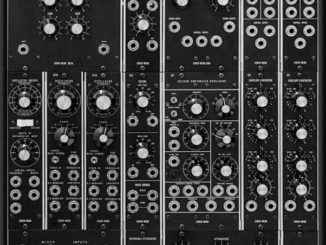Pittsburgh Modular has turned its semi-modular wavefolding analog Synthesizer Taiga into a more feature-rich, modular keyboard instrument.
Last year (2023), in January, Pittsburgh Modular unveiled Taiga. One of the most exciting semi-modular synthesizers of recent years as it brings together East- and West-Coast elements in an original synth. It is neither an attempt to revive a Moog nor a Buchla from the past. It’s a Pittsburgh synth.
Taiga landed on my list of the best hardware experimental synthesizers in 2023 because its feature set and patch bay allow you to delve deeply into sound design. In 2024, they go one step further, dock keys and wheels to Taiga, enlarge the interface and provide space for addons. Please welcome the Taiga Keyboard.
Pittsburgh Modular Taiga Keyboard vs Desktop
Pittsburgh Modular Taiga Keyboard and Taiga Desktop are identical in most features. It offers three oscillators with sine, triangle, and saw, combinable and shapable with FM and through a 6-stage west-coast-ish wavefolder. Plus, you get a unique-pitched noise generator.
According to Richard Nicol of Pittsburgh Modular, it has new full-range oscillators with dedicated coarse and fine-tune pitch controls. From here, it goes straight into the original “no-dead-spots” filter with combinable lowpass, bandpass, and highpass modes.
On the modulation side, you can work with all the familiar functions of the Taiga desktop: two analog ADSR envelopes, a wide-range analog LFO (square/triangle), a S&H circuit, and the digital multi-mod tool. This can be a random generator, an extra LFO, or an envelope generator.
Exclusive in the Taiga Keyboard is a second analog LFO, giving you three LFOs if you also use the digital tool as a low-frequency oscillator.
The special twist on the VCA is also available in the Taiga Keyboard. It hosts Pittsburgh’s dynamic section based on the concept of a lowpass gate with added release time but without vactrols. It manipulates both the amp and harmonic content of the signal. This replacement for the env + VCA combo enables more organic, soft-sounding timbres.
Then, you get a dual-channel mixer for audio and CV signals, and a preamp with a high-gain, soft clipping overdrive limiter. The latter brings your external signals to the Eurorack level or can be used to add juice to the internal sound.
Extra neat tools like an internal clock, a clock divider, an arpeggiator, and an analog bucket brigade delay/echo are also onboard.
Semi-Modular To Modular
Taiga is a semi-modular 3-voice paraphonic Synthesizer in terms of circuitry. Functions can’t be removed like modules. That would be nice. However, thanks to the extensive patch bay hosting 64 points, you can use and patch it like a modular synth.
The new keyboard version takes the modular idea further at the right end of the interface. Take down the colorful faceplate, and the full modularity of Taiga Keyboard unfolds. You can access a 24HP powered Eurorack modular expansion bay to expand the synth with your favorite modules.
There are almost no limits to your creativity here. Okay, the modules can’t have more than 24HP. You can add more modulation or effects to it, upgrade it with a second filter, turn Taiga into a modular groovebox using the 1010music bitbox micro, and more—a great option for creating your very personalized instrument.
Keyboard + I/O Specs
The new keyboard version also allowed the developers to make the interface larger and more accessible. There is more space between the knobs and so it is a different tweaking experience. In the Taiga Desktop, the functions are relatively close to each other.
Further, we take a look at the specs of the built-in keyboard. You get 37 full-sized keys with velocity and aftertouch with added left-side pitch and mod wheels. Alternatively, you can control it with CV/gate, another MIDI keyboard, or the integrated pseudo-random sequencer mode.
On the back, you get a power on/off switch, a power supply input, audio input and output, MIDI I/O, and a USB port. And here is the overdose of first-day video content.
Pittsburgh Modular Taiga Keyboard First Impression
That’s a surprise. A keyboard version of the Taiga was not on my radar. I find the idea of a standalone keyboard synth with Eurorack expandability fascinating. We already have the NiftyKEYZ keyboard from Pittsburgh’s partner company, Cre8audio, where you can assemble your dream modular keyboard synth using modules.
This goes in the same direction as the NIFTYKEYZ, but with the difference that you expand an existing synth here instead of building an entire synth from scratch. This turns an actual semi-modular into a modular one. It reminds me of the Arturia MiniBrute 2 series, just with the difference that you must attach a case to it to make it “modular”.
Pittsburgh Modular Taiga Keyboard is available now for 1359,99€. It ships with the synth, a wall-wart power supply, and 10x Nazca Noodles patch cables.
More information here: Pittsburgh Modular
Available at my partner






 Pittsburgh Modular Taiga Keyboard
Pittsburgh Modular Taiga Keyboard


For that price, I’ll buy a Sequential Take 5 or Hydrasynth.
Welp, they got this out just before I was about to pull the trigger on the desktop. I’ll get the keyboard version… This is just awesome! Way to go Pittsburgh Modular…
Not inexpensive. I guess it always shows if a company with a modular background starts approaching the non-modular synth world. Then you see integrated synths usually are better value for money. But okay it’s a different way of music making, so ‘value’ depends really on what you aim to do with it.
Glad to see Pittsburgh pushing the envelope. As a fan, they’ve been following their own interesting thread in recent years. Excited to see what they have for their upcoming drum machine. Not to mention the next VRL. Nicely done PM crew.
I have been admiring Pittsburg Modular from afar, but will push me into purchase mode. This thing sounds great and looks like a ton of fun to use. While not inexpensive, it’s a steal when compared to a rack with comparable functionality.
No thanks. Relic makers!
When people dismiss instruments for being “relics” or similar, it always makes me curious about when the seeds of their art was sown.
Fair statement, I think my issues with PM is more about the their beliefs about analogue platform than their own creations per se. Barton would like to speak to Nichols about a thing or two….